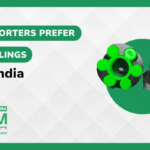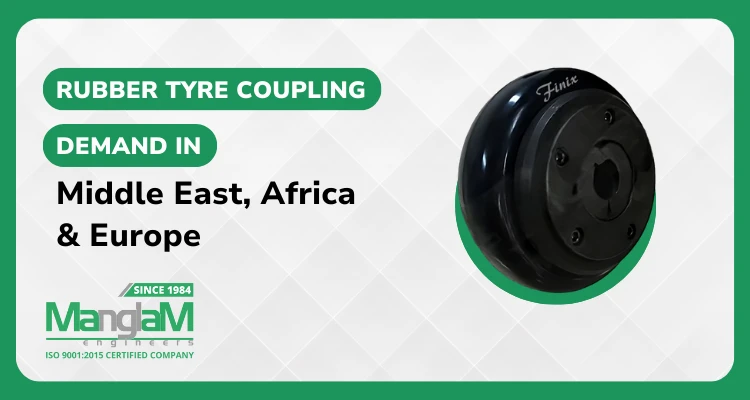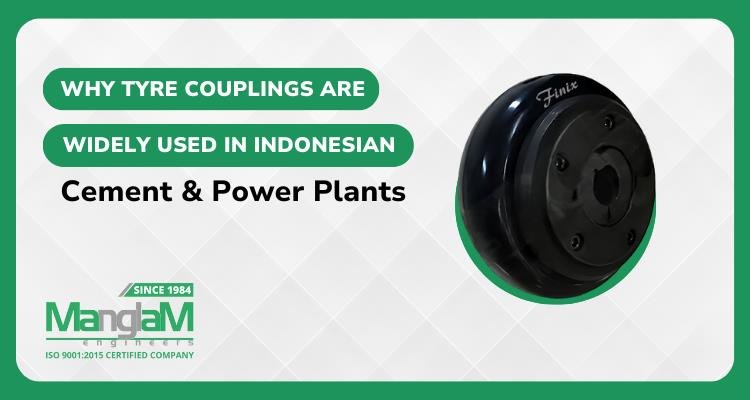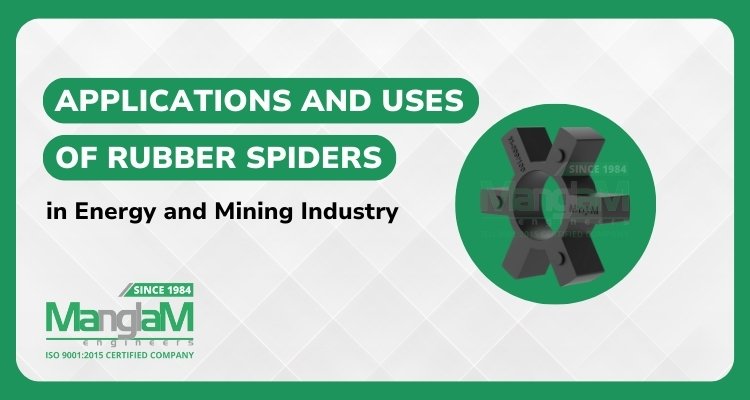
Why Importers Prefer MT Couplings from India
September 22, 2025
How to Choose the Right Transmission Coupling (With Cost-Saving Tips)
October 7, 2025Introduction
The global demand for rubber tyre couplings is surging, especially across the dynamic industrial landscapes of the Middle East, Africa, and Europe (MEA & Europe). This growth isn't accidental; it's inspired by quick industrialization, a relentless focus on machinery uptime, and the basic advantages of these flexible yet stable components. For OEMs, EPC contractors, and industrial buyers, understanding this trend is key to optimizing operations and staying competitive.
At Manglam Engineers, we've been at the peak of this evolution, supplying high-performance mechanical couplings that power industries worldwide. This analysis dives deep into the market drivers, regional trends, and technical benefits shaping the rubber tyre coupling demand today and what to expect in the coming years across these key regions.
What's Impacting the Global Demand for Rubber Tyre Couplings?
The core reason for the rising demand is that rubber tyre couplings offer an exceptional balance of performance, durability, and cost-effectiveness. They are the go-to solution for absorbing shock, damping vibrations, and accommodating shaft misalignments in rotating equipment, which directly translates to longer machinery life and reduced maintenance costs.
Industrial growth is the primary cause. As new factories, power plants, and infrastructure projects come online in the MEA region and as European industries upgrade existing machinery, the need for reliable power transmission components like these couplings is growing. They are a critical, albeit small, part of a much larger system that keeps industries moving.
Why is the Middle East a Hotspot for the Rubber Tyre Coupling Market?
The Middle East is a key growth market for rubber tyre couplings primarily due to its massive investments in infrastructure, oil and gas, and giga-projects. The region's strong economic growth plans, such as Saudi Arabia's Vision 2030, are creating an unprecedented need for industrial machinery in large-scale construction projects like NEOM and the Red Sea Project.
In these demanding environments, equipment is often subjected to harsh conditions, extreme heat, and continuous operation. Flexible rubber tyre couplings are essential for protecting expensive machinery like pumps, compressors, and generators from shock loads and vibration, ensuring operational reliability. This makes them a non-negotiable component for projects where downtime is not an option.
What are the Key Applications in the Middle East?
In the Middle East, rubber tyre couplings are especially used in:
- Oil & Gas: For powering centrifugal pumps, compressors, and pipeline equipment where reliability is a priority.
- Construction: In concrete mixers, aggregate conveyors, and heavy-duty cranes used in the region's iconic giga-projects.
- Water & Wastewater: For driving aerators, pumps, and desalination plant machinery that runs 24/7.
- Manufacturing: In general, industrial machinery, from production lines to district cooling (HVAC) systems.
As leading rubber tyre coupling suppliers in the Middle East, we see firsthand how these applications demand components that can withstand the region's unique environmental and operational challenges.
How is Africa's Industrial Growth Increasing Coupling Demand?
Africa's demand for rubber tyre couplings is driven by the rapid expansion of its mining, agriculture, and manufacturing sectors. The continent is rich in natural resources, and as investment flows into extracting and processing these materials, the need for efficient and low-maintenance machinery components is skyrocketing. This is particularly true in the resource-rich mining belts of Southern and Central Africa and the rapidly advanced agricultural sectors in West and East Africa.
The challenge in many parts of Africa is the remote location of industrial sites. Therefore, components that are easy to install and require minimal maintenance are highly valued. The "fit and forget" nature of high-quality rubber tyre couplings makes them an ideal choice, minimizing the need for specialized technicians and reducing long-term operational costs.
Which African Industries Depend Most on These Couplings?
The most significant demand in Africa comes from:
- Mining & Quarrying: On conveyors, crushers, and screening equipment where shock loads are severe and constant.
- Agriculture: In irrigation pumps, harvesting machinery, and food processing equipment.
- Power Generation: Connecting engines and generators in both large-scale power plants and smaller, off-grid solutions.
- Cement & Aggregates: For heavy-duty applications in kilns, mills, and material handling systems.
Manglam Engineers has extensive experience as rubber tyre coupling exporters to Africa, providing solutions that are engineered to handle the continent's unique operational challenges.
What Trends are Shaping the European Rubber Tyre Coupling Market?
The European market is mature, with a strong focus on high efficiency, automation, and commitment to stringent safety standards (like ATEX for explosive atmospheres). This aligns with continent-wide initiatives like Germany's 'Industrie 4.0', which prioritizes smart, automated, and highly efficient manufacturing processes.
While new projects drive some demand, a significant portion comes from retrofitting and upgrading aging industrial infrastructure to improve performance and energy efficiency. European manufacturers prioritize precision and longevity, seeking high-performance rubber couplings that offer predictable performance. The ability of tyre couplings to reduce noise and vibration is also a key selling point in a market with strict workplace health and safety regulations.
What are the Main Benefits of Using a Flexible Rubber Tyre Coupling?
A flexible rubber tyre coupling is more than just a component; it's an insurance policy for your rotating equipment. Its unique design provides several distinct operational advantages that protect your investment and boost efficiency.
- Superior Misalignment Compensation: It easily accommodates parallel, angular, and axial misalignments between shafts, reducing stress on bearings and seals.
- Excellent Shock & Vibration Damping: The flexible rubber element acts like a shock absorber, protecting the entire system from sudden torque spikes and harmful vibrations.
- Torsionally Soft Design: This "soft start" capability prevents damage during motor startup, especially in sensitive systems.
- Simple, "Blind-Fit" Installation: Installation is incredibly easy and can often be done without moving the motor or driven machine, saving significant time and labor.
- Maintenance-Free Operation: Unlike many other coupling types, rubber tyre couplings require no lubrication, eliminating a recurring maintenance task.
- Permanent Safety: The rubber element provides electrical insulation and a fail-safe design, meaning it can still transmit torque for a short period even if the element fails, allowing for a safe shutdown.
How Do Rubber Tyre Couplings Compare to Other Couplings?
Choosing the right coupling is critical for system performance. While every coupling has its place, the rubber tyre design offers a unique balance of features. Here’s a quick comparison with other popular types offered by Manglam Engineers.
| Feature | Rubber Tyre Coupling | Jaw Coupling | Gear Coupling |
|---|---|---|---|
| Misalignment Capacity | Excellent (Parallel, Angular, Axial) | Good (Angular, Parallel) | Excellent (Angular, some Axial) |
| Vibration Damping | Excellent | Good | Poor |
| Torsional Stiffness | Low (Torsionally Soft) | Medium to High (Depending on spider element) | Very High (Torsionally Stiff) |
| Maintenance | None (No Lubrication) | None (Check spider element periodically) | Requires regular lubrication |
| Installation | Very Easy (Blind fit) | Easy | Moderately Complex (Requires precise alignment) |
| Best For | Pumps, Fans, Compressors, General Industrial Machinery | Servo motors, Encoders, Light to Medium Duty applications | High Torque, High Speed, Heavy-Duty Industrial applications |
This table shows that for general-purpose industrial applications where misalignment and vibration are present, the rubber tyre coupling is often the most practical and cost-effective solution.
What Should You Look for in a Rubber Tyre Coupling Supplier?
Partnering with the right supplier is as important as choosing the right component. A good supplier doesn't just sell a product; they provide a solution. When sourcing industrial rubber tyre couplings, look for a partner who offers:
- A Complete Product Portfolio: A supplier should offer a wide range of couplings, including Tyre Couplings (RRL, RRS types), Jaw Couplings (Normex, Rotex types), HRC Couplings, Pin Bush Couplings, and more. This ensures they can provide the optimal, fair solution for your specific application.
- Proven Quality and Manufacturing Excellence: Look for ISO certification and a track record of reliability. The quality of the rubber compound and the precision of the metal hubs are critical for performance and longevity.
- Global Export and Supply Chain Capability: Your supplier must be able to deliver components reliably to your project sites, whether they are in Dubai, Johannesburg, or Frankfurt. Experience in international logistics and documentation is crucial.
- Deep Technical Expertise: The best suppliers act as technical partners. They should have an engineering team that can assist with selection, sizing, and troubleshooting to ensure you get the most out of your investment.
At Manglam Engineers, we pride ourselves on checking all these boxes, providing not just components but complete power transmission solutions to our clients across the MEA and Europe.
Partner with Manglam Engineers for Your Coupling Needs
The growing rubber tyre coupling demand in the Middle East, Africa, and Europe presents a clear opportunity to enhance industrial efficiency and reliability. These components are proven generators, delivering exceptional performance in the toughest conditions.
As a trusted global manufacturer and exporter, Manglam Engineers is perfectly positioned to meet this demand. With our extensive range of high-quality couplings, deep engineering expertise, and commitment to customer success, we are more than a supplier—we are your partner in power transmission.
Ready to secure a reliable supply of high-performance couplings for your next project?




